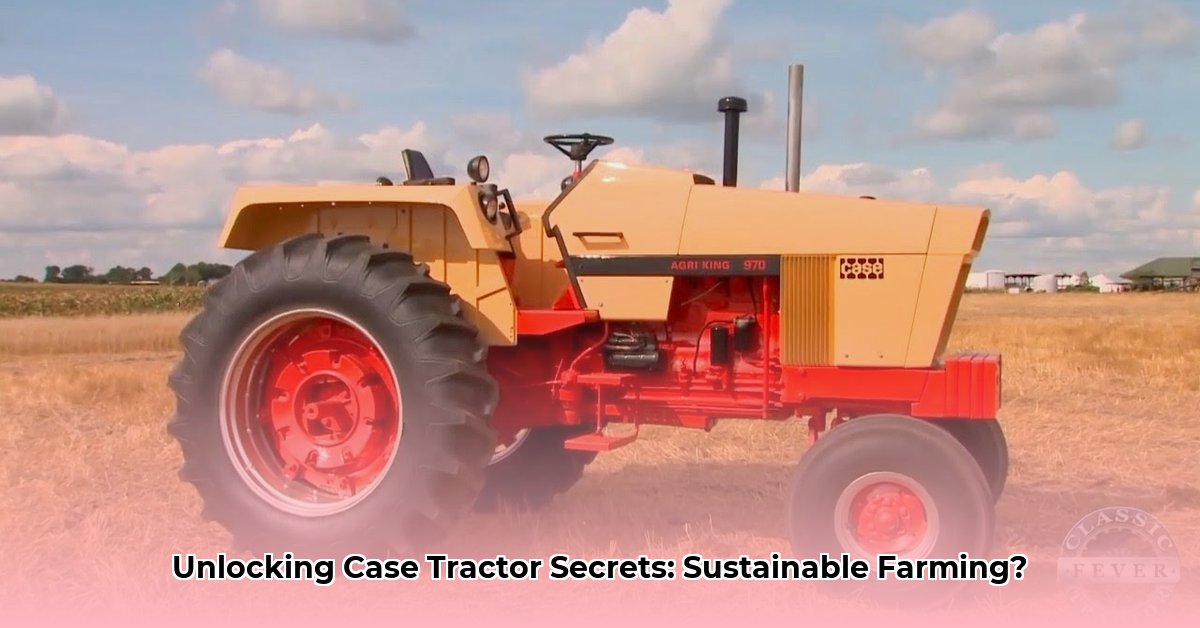
Detailed Specifications of the J.I. Case 970 Tractor
The J.I. Case 970, manufactured between 1970 and 1978, represents a significant milestone in agricultural mechanization. This analysis delves into its specifications, comparing them to modern counterparts and assessing its role within the context of sustainable agriculture. Understanding its capabilities and limitations provides valuable insight into the evolution of farming technology and its environmental impact. For more Case tractor information, see this additional resource.
Engine and Powertrain
The Case 970 offered a choice between gasoline and diesel engines, a key differentiator impacting fuel efficiency and emissions. While precise horsepower figures vary depending on the engine and measurement method, estimates range from approximately 70 to 94 horsepower. The available transmissions included an 8-speed unsynchronized gearbox and a 12-speed partial power shift transmission. The fuel tank capacity, typically around 50 gallons (189 liters), dictated operational range before refueling. The choice between gasoline and diesel significantly impacts fuel consumption and greenhouse gas emissions. Modern tractors, by contrast, utilize more fuel-efficient engines and advanced electronic controls to optimize performance and reduce fuel usage.
Dimensions and Hydraulics
The Case 970's dimensions (weight, length, width, height) influenced its maneuverability and operational capabilities. Precise measurements depend on the specific configuration and added weights, but typical figures are in the range of 10,050 to 11,190 lbs (4560 to 5075 kg). The hydraulic system specifications, encompassing lift capacity and other parameters, are crucial in assessing the range of implements the tractor could effectively operate. These specifications, unfortunately, are less readily available from readily accessible sources. Additional research is needed to provide a complete picture. In contrast to the 970, modern tractors boast significantly enhanced hydraulic systems, allowing for more precise control and varied implement use.
Three-Point Hitch and PTO
The Case 970 featured a Category II three-point hitch, a standardized connection point for many implements of the era. The power take-off (PTO) specifications—power output and rotational speed (RPM)—determined its compatibility with various power-driven implements. While specific specifications might be unearthed through archival research or owner's manuals, these parameters are essential for understanding the tasks this machine could perform. Modern tractors often offer multiple PTO options and electronic control over PTO operation.
Comparative Analysis: Case 970 vs. Modern Tractors
How does the Case 970 compare to modern agricultural tractors? The most striking difference lies in fuel efficiency and emissions. Modern tractors, benefiting from advanced engine technology and more sophisticated electronics, exhibit significantly lower fuel consumption per hour and reduced greenhouse gas emissions. This leads to lower operating costs and a smaller environmental impact. Furthermore, modern tractors often incorporate GPS-guided technologies and advanced implement control systems, maximizing efficiency and minimizing resource waste.
How much more fuel-efficient are modern tractors? While precise quantification for the 970 is challenging due to limited readily available data, studies show modern tractors can achieve fuel savings of up to 30-40% compared to older models. This alone highlights the considerable environmental gains from technological advancement. The absence of advanced electronics in the 970 means a reduction in precision agriculture applications and potential for increased resource usage.
Sustainability Assessment: The 970's Environmental Footprint
The Case 970's legacy in sustainable agriculture presents a mixed picture. The gasoline engine option, if chosen, resulted in considerably higher greenhouse gas emissions than modern diesel or alternative fuel options. Even the diesel option, while more environmentally friendly than gasoline, lags behind current standards. Moreover, limited data exists on the environmental impact of maintenance and waste generation—oil changes, filter replacements, and eventual disposal of the tractor itself. Quantifying these aspects requires thorough, often challenging, research within archival records and specialized databases.
A full life cycle assessment (LCA) is crucial for a comprehensive understanding of the Case 970's environmental impact. Such an LCA would consider the resource use throughout its manufacturing, operation, and end-of-life phases and provide a more complete sustainability assessment. This assessment would compare the tractor's environmental influence to modern equipment and set a benchmark for future sustainable farming practices.
Historical Context: Farming in the 1970s
The Case 970's design reflects the agricultural and technological landscape of the 1970s. Mechanization was progressing rapidly, but environmental regulations were less stringent. Understanding this context helps clarify the differences between the 970 and contemporary, sustainability-focused tractors.
Conclusion: A Legacy of Innovation and Environmental Consideration
The J.I. Case 970 holds a significant place in agricultural history, representing a pivotal point in mechanization. However, its sustainability credentials are clearly limited when compared to modern tractors. The significant differences in fuel efficiency, emissions, and technological capabilities highlight the rapid advancements in sustainable agricultural practices. Further research, particularly a comprehensive life cycle assessment, is crucial to fully understand the 970's overall ecological impact. This research will allow for a fuller understanding of the interplay between technological innovation and environmental responsibility in the ever-evolving world of agriculture.